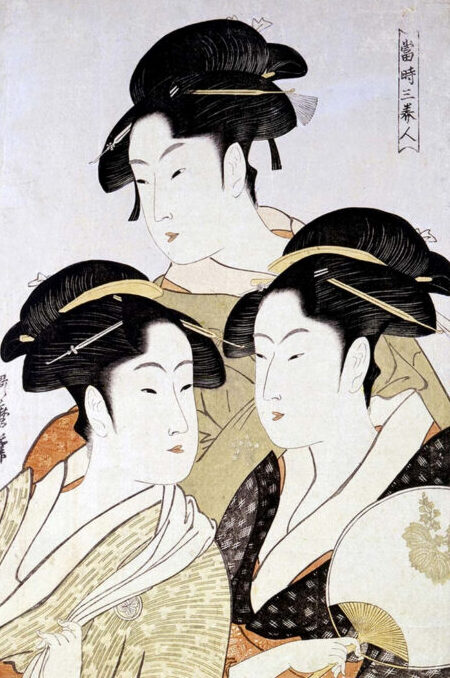If you’ve ever heard someone say that Japanese women only go to university to find a husband with a solid paycheck and a decent jawline, congratulations — you’ve encountered one of the most persistent and frustrating stereotypes still hanging around the faculty lounge of modern life. This idea, often whispered over teacups or TikToks, seems to reduce years of cultural evolution, education reform, and the aspirations of half the population into one tidy cliché. And while some women in Japan (and everywhere else, for that matter) may indeed meet their partners at university, the notion that it’s the primary reason they attend feels a bit like saying people go to cafés just to photograph lattes. There’s a bit of truth, maybe, but a whole lot of missing context.
To understand how we got here, we need to rewind a little back to the days of shrine maidens, or miko, who were often the only women in a community allowed a kind of public spiritual authority. They performed rituals, danced, and channeled the gods. But despite their cultural importance, they weren’t exactly being groomed for university entrance exams. Fast forward a few centuries and you’ll find geisha, another iconic (and equally misunderstood) group of women. These weren’t just performers with perfect eyeliner, they were highly trained artists, musicians, conversationalists, and sometimes literary talents in their own right. Think of them as elegant evening-school students whose curriculum included shamisen and subtle wit. Women in Japan have always found ways to express intelligence, creativity, and agency, even when official systems boxed them in. One of the clearest places this showed up was in writing.
Historically, Japanese women developed their own writing system – hiragana – because the elite men were all busy writing in Chinese characters (kanbun) and frankly didn’t think women needed much in the way of written language. So women invented one. This “feminine” script was more fluid, elegant, and well-suited to literary expression. It gave us classics like The Tale of Genji, written by Murasaki Shikibu, who might today be accused of “only enrolling in court to meet a nice nobleman,” when in fact she basically invented the psychological novel. The onnade (women’s hand) style not only gave women a voice but shaped Japanese literature itself. Compare that to the West where women like Mary Wollstonecraft or Jane Austen had to fight for both readership and relevance. The parallels are striking both cultures found ways to elevate women’s voices despite social expectations that they remain quiet, pretty, and preferably engaged to someone with good land holdings.
Then came the Imperial Rescript on Education in 1890. It sounded noble. It wasn’t. Alongside encouraging loyalty to the Emperor and nationalistic ideals, it kindly reminded girls that their ultimate goal was to become “good wives and wise mothers.” A lovely sentiment if you’re a decorative vase. Education for women was mostly limited to homemaking, etiquette, and moral development. You know, just enough to raise future soldiers but not enough to ask why they were marching in the first place. Critics today rightly point out how this codified patriarchy, suppressed feminist movements like the Bluestocking Society, and turned classrooms into prep schools for domestic submission.
So where are we now? Modern Japanese universities are filled with brilliant women studying everything from robotics to Renaissance literature. And yet, the lingering belief that women are just there to nab a husband before they hit 25 is stubborn. It doesn’t help that “job hunting” (shūkatsu) and “husband hunting” (konkatsu) have become overlapping social pressures, both with strict timelines and proper attire. But here’s the thing, that overlap exists in the West too. You just might hear it phrased as “ring by spring” in American colleges or subtle British matchmaking efforts disguised as Sunday brunch. The stereotype isn’t uniquely Japanese. But the persistence of it, especially in a country with such a rich history of women writing, creating, and resisting quietly and beautifully, feels particularly ironic.
Education in Japan, like elsewhere, is evolving. Women are pushing boundaries, starting companies, running labs, writing novels, coding apps, and yes, occasionally falling in love at university. But that last part doesn’t erase the rest. So let’s stop pretending that a degree is just a fancy dating profile and start remembering that intelligence and affection are not mutually exclusive. After all, it’s perfectly reasonable to want a PhD and a partner who doesn’t flinch at dish duty. Or in the words of one wise miko probably never allowed near a chalkboard: you can hold a brush and a boyfriend. Just don’t confuse the two.
Three Beauties of the Present Day by Kitagawa Utamaro (1793)
Author’s Note:
This article is part historical reflection, part cultural roast. The intention isn’t to mock tradition but to highlight the resilience and creativity of Japanese women across centuries, often told to be quiet, but finding louder ways to speak. As always, any stereotypes should be handled with curiosity and context, not judgment. Especially if your idea of a productive university experience includes both books and butterflies in your stomach.


Leave a Reply